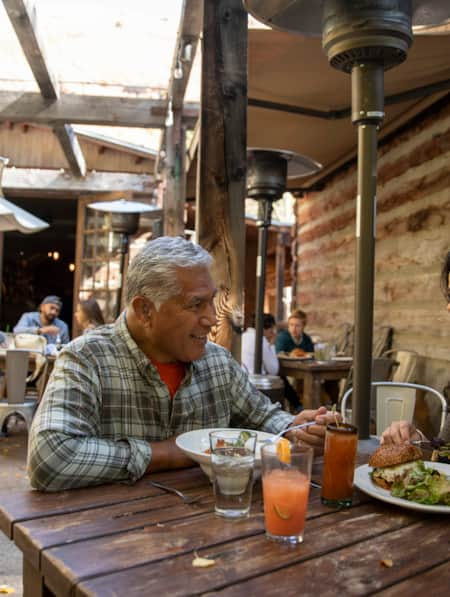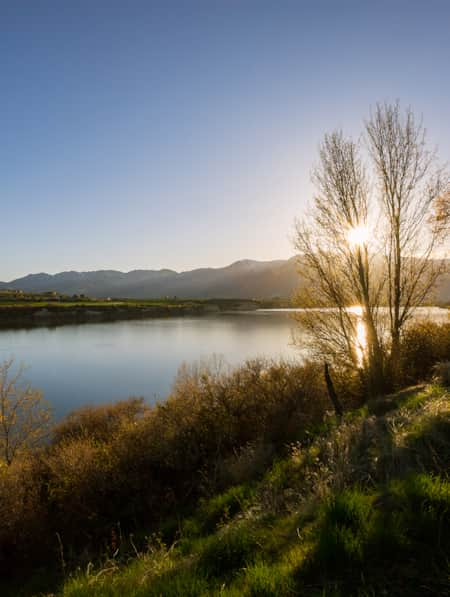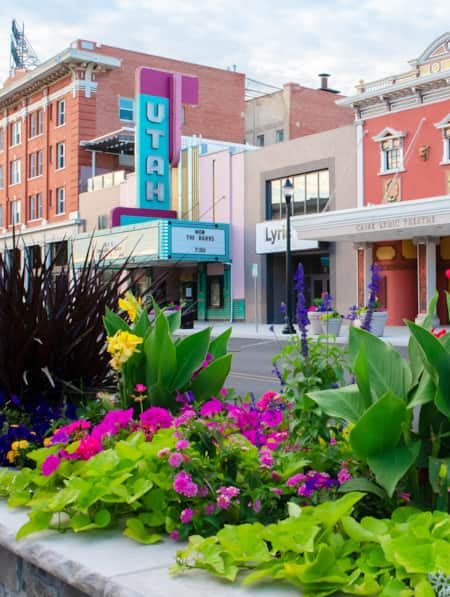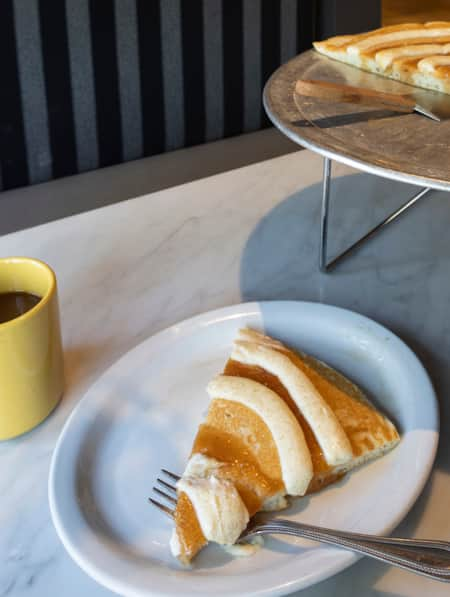Cache Valley’s Rich Past and Thriving Present
Stretching from Logan to Great Salt Lake, tour these history-anchored spots to learn more about Cache Valley’s history and heritage.

Northern Utah’s Cache Valley has been known by many names. Indigenous Newe (Shoshone) people called it Seuhubeogoi (Willow Valley), for the prolific riverbank willows of the region. Early Swiss immigrants nicknamed it the Little Switzerland of the Rockies, with snow-capped mountains and rolling green foothills that evoked the previous homeland of the pioneer dairy farmers who settled the area in the 1850s.
But the name of Cache Valley has stuck for nearly 200 years, a title bestowed by fur trappers who stashed their caches of furs harvested from the region’s abundant wildlife. That abundance is thanks to the Bear River and its tributaries, the Logan and Malad rivers, whose waters flow into Great Salt Lake. That rich watershed is bounded by soaring mountains, the Wellsville Mountains to the west and the Bear River Mountains to the east, in a valley whose history is inextricably meshed by the complex friction of Native settlement and expansionist ideologies.
Cache Valley’s northern rim stretches to Battle Creek (near Preston, Idaho) the site of 1863’s Bear River Massacre, considered the largest single mass killing of Indigenous people in United States history. Members of the So-so-goi, “those who travel on foot,” also called the Northwestern Band of the Shoshone Nation, have shared their experiences and expertise at many of the region’s cultural heritage sites mentioned here. The valley is anchored by the bustling college town of Logan, home to Utah State University, founded in 1888 as the state’s agricultural college. To the south is charming Brigham City — adjacent to Utah’s “Fruit Way”— and the threshold to the Bear River Migratory Bird Refuge, the largest freshwater wetlands of the Great Salt Lake ecosystem.
Tour these history-anchored spots to learn more about Cache Valley’s rich past and thriving present.
American West Heritage Center
4025 S. Highway 89-91, Wellsville
awhc.org
(435) 245-6050
Hours vary seasonally; closed Sunday
The American West Heritage Center merges education and entertainment on a 275-acre living history site that replicates a small frontier settlement, focusing on exploring the cultural history of Cache Valley from 1820 through the 1920s. Guests can explore the site’s many interpretive elements, such as the mountain men trading post, woodworking shop and pioneer dwellings (some buildings are replicas, while others are historic structures moved to the AWHC from other locations). The AWHC is a working farm, and many of the center’s seasonal events celebrate the region’s agricultural heritage, from Baby Animal Days beginning in late March — with, you guessed it, a petting zoo — to a corn maze during the Fall Harvest Festival. Weekends in December, the center’s annual horse-drawn sleigh rides draw families returning year after year to sing along with costumed carolers, zip down the sledding hill (BYO sled) and sip steaming mugs of gourmet cocoa. The center’s busiest season is summer, with programming scheduled daily (Tuesday through Saturday) including live demonstrations, hands-on activities like gold panning and ax throwing, and pony rides for children.
A note on winter hours: With the exception of the sleigh-ride events, AWHC mostly shutters for the winter season, though you can stop in at the visitor center during office hours to tour the small historical museum and gift shop.

The 275-acre American West Heritage Center just south of Logan showcases the region’s heritage with costumed mountain men, pioneers, and farmers portraying a bygone era.
Photo: Nicole Morgenthau

The center’s historic daily adventures take learning to another level. The woodwright shop is a great opportunity to learn about historical woodworking techniques.
Photo: Julie Hollist Terril
Cache Pioneer Museum
160 N. Main Street, Logan
cachedupmuseum.org
(435) 752-5139
Hours vary seasonally; closed Sunday
The Cache Pioneer Museum’s permanent exhibit orients visitors with an in-depth exploration of the regions Indigenous Newe (Shoshone) people and provides a thoughtful cultural context to the larger exhibit space exploring the area’s historical, religious and political history. The museum’s mission primarily focuses on the material culture of the first few generations of Mormon settlers, and it has hosted award-winning temporary and online exhibits on numerous topics. Following a major remodel of both the museum exhibit hall and the historic building’s overall accessibility, the Cache Pioneer Museum continues to exceed expectations for community and local history, while also offering videos and digital research tools for visitors.
Note: The wheelchair ramp and entrance are on the south site of the building, accessible from Federal Avenue. Hours vary by season, and the incredibly helpful all-volunteer staff are adept at fielding general questions and specific family research inquiries.
Golden Spike National Historical Park
6200 N. 22300 West, Promontory
nps.gov/gosp
(435) 471-2209
Hours vary seasonally
Between 1863 and 1869, the nation’s first Transcontinental Railroad was built by tens of thousands of workers from all over the world, including Chinese and European immigrants, enslaved African Americans, Civil War veterans, Native Americans and Mormon settlers. The main exhibit space and outdoor public art installations of Golden Spike National Historical Park explore the many people involved, technologies developed and economic and political challenges faced by this project that revolutionized the settlement and commerce of the American West. One new public sculpture, Ilan Averbuch’s “Monument to their Memory,” was installed in 2002. It’s an 11-foot wide, 24-feet tall artwork resembling a vertical railroad track, honoring workers from different cultures and backgrounds. Many visitors are drawn to the park by the historic train locomotives, which serve as a massive testimony to the grit, determination and skilled mechanics involved in this technological feat. From mid-October to late April, the park’s locomotives are viewable in the Engine House while they are undergoing maintenance, and during the summer months run the tracks for demonstrations (see the train schedule for details). Several self-directed driving tours allow visitors to drive parts of the historic railroad grade and provide information about building techniques and technologies (some routes closed in winter). Truly adventurous travelers can take on the challenge of driving the historic Transcontinental Railroad National Backcountry Byway (not advised for faint hearts or fragile tires).

One of the most iconic and life-altering events in the United States history — the completion of the Transcontinental Railroad — happened in Utah on May 10, 1869.
Photo: Mel Lewis

Today, visit the Golden Spike National Historic Park to relive the history with exhibits and demonstrations, and take in the beauty of the surrounding Great Basin Desert and nearby Great Salt Lake and Spiral Jetty.
Photo: Marc Piscotty
Hardware Wildlife Education Center
Blacksmith Fork Canyon Road, State Route 101, Hyrum
wildlife.utah.gov/hardware
(535) 753-6206
Hours vary seasonally
The 16-mile drive up beautiful Blacksmith Fork Canyon is an adventure year-round, revealing stunning mountain views and frequent sightings of wild turkeys, mule deer, and raptors and songbirds. The road ends at the historic site of Hardware Ranch, which was purchased by the state of Utah in 1945 and is operated by the Utah Division of Wildlife Resources as the Hardware Wildlife Management Area. Access to hiking and wildlife viewing abound, and the Hardware Wildlife Education Center has exhibits outside the winter season (select weekends, see website for details). The exhibits feature information about local wildlife and hands-on activities for kids. Large herds of elk have historically gathered in the area for their winter range, and DWR biologists take advantage of this opportunity to test the herd for disease and overall health. From roughly mid-December through early February, horse-drawn sleigh or wagon rides are offered tracking through the meadow filled with hundreds of elk, making for a fun family-friendly activity — be sure to bundle up!
Museum of Anthropology
252 Old Main, Utah State University, Logan
chass.usu.edu
(435) 797-7545
Hours: Tuesday-Friday, 10 a.m.-5 p.m. (call ahead for summer hours)
Utah State University’s Museum of Anthropology features rotating exhibits that reflect the current research passions of the department’s students and faculty, a continual work-in-progress in the best way. The museum features wide-ranging worldwide archaeological and ethnographic collections — from prehistoric stone tools to modern textiles. It serves the community at large as both an educational resource and teaching environment, with student teams taking on the experience of conceptualizing and installing thematic exhibits from the museum’s collections. The museum also routinely brings in experts for events and exhibit consultation, from local Native American storytellers, to artists from cultures around the world. If you’re on campus the first Saturday of the month (10 a.m.-2 p.m.), the museum’s Family First Saturdays hands-on activities have become very popular.
Intermountain Herbarium
5305 Old Main Hill, Utah State University, Logan
usu.edu/herbarium
435-797-0061
Hours: Monday–Friday, 8 a.m.–5 p.m. (call ahead for summer hours)
For those who believe nature is in-and-of-itself art, a stop at the Intermountain Herbarium in Utah State University’s Old Main quad is a must-do activity to learn more about the flora and fungi of the region. Located in the basement of the USU Junction Building — reached via exterior stairs on the north side of the building — the Intermountain Herbarium is a working repository of more than 280,000 vascular plant, fungi, lichen and bryophyte (mostly moss) specimens. You’ll find specimens collected from all over the world and pressed into folios, yet the herbarium’s research treasure trove is the substantial collection of native and introduced grasses and plants from the Intermountain West. These are used as points of reference for everything from archaeologists comparing fibers collected during excavations to researchers studying the effects of climate change. The herbarium is also open to the public for specific research questions (“what is this weird plant in my yard?”) or general curiosity-seeking. Larger groups should check in with the herbarium manager in advance to assure adequate staffing and assistance for a tour.
Brigham City Museum of Art & History
24 N. 300 West, Brigham City
brighamcitymuseum.org
(435) 226-1439
Hours: Tuesday–Friday, 10 a.m.-5 p.m.; Saturdays 1-5 p.m.
When in Brigham City, don’t miss the Brigham City Museum of Art & History, which explores the region’s diversity through permanent exhibits and a large, central rotating exhibit space — bringing together Utah artists, media of all kinds and historical exhibits. A large hall is dedicated to the history of the area’s human experience, from Indigenous peoples to The Church of Jesus Christ of Latter-day Saints’ experiment in cooperative commerce — the Brigham City Mercantile & Manufacturing Association. The association encouraged home industries such as silkworm husbandry and silk production (called sericulture), skilled trades and an overall goal of creating an almost entirely self-sufficient community supported by a single mercantile operation. The gem of this museum is the central rotating exhibit space dedicated to the celebration of past, present and a hopeful future of ideas, creativity and heritage; up to six temporary exhibits on display at any one time. The museum occupies the entire lower level of Brigham City’s Community Center, at the intersection of Forest Street and 300 West. (Read: Caching in on the Arts in Northern Utah)
Hyrum City Museum
50 W. Main Street, Hyrum
hyrumcitymuseum.org
(435) 245-0208
Hours vary seasonally; closed Sunday
How do you tell the tale of a historic townscape long gone, and advocate for a diverse and welcoming future in days to come? The Hyrum City Museum celebrates both the history of a much-changed Main Street and the continuing pride and perseverance of this modern mountain community. It’s focused on the material culture of early settlers — including a charming diorama of the original town plat — to thriving businesses of the early 1900s, with a timeline exploring the material culture and photographs of Spanish-speaking immigrant workers in the region’s dairy industry becoming part of the fabric of the community. One of the museum’s most thoughtful and compelling exhibits is “Boa Ogoi: The River is Life,” an installation and virtual exhibit created in collaboration with the Northwestern Band of Shoshone to “tell their story, restore their land, and find healing by creating a community for their future.” Visitors approach the museum from the rear parking lot, on the basement floor of the city’s library and community building. For special events and summer hours, the two relocated historic cabins on the center’s lawn are run by the youth society, where visitors can buy penny candy and other refreshments. Big band swing dance and jazz aficionados take note: Next door, the 1915 historic Elite Hall hosts hopping (literally) events on the hall’s spring-loaded dance floor year-round.

Caching in on the Arts in Northern Utah
Visitors will find a concert, exhibit or festival around nearly every corner when Cache Valley shakes off winter and early spring snow.




























